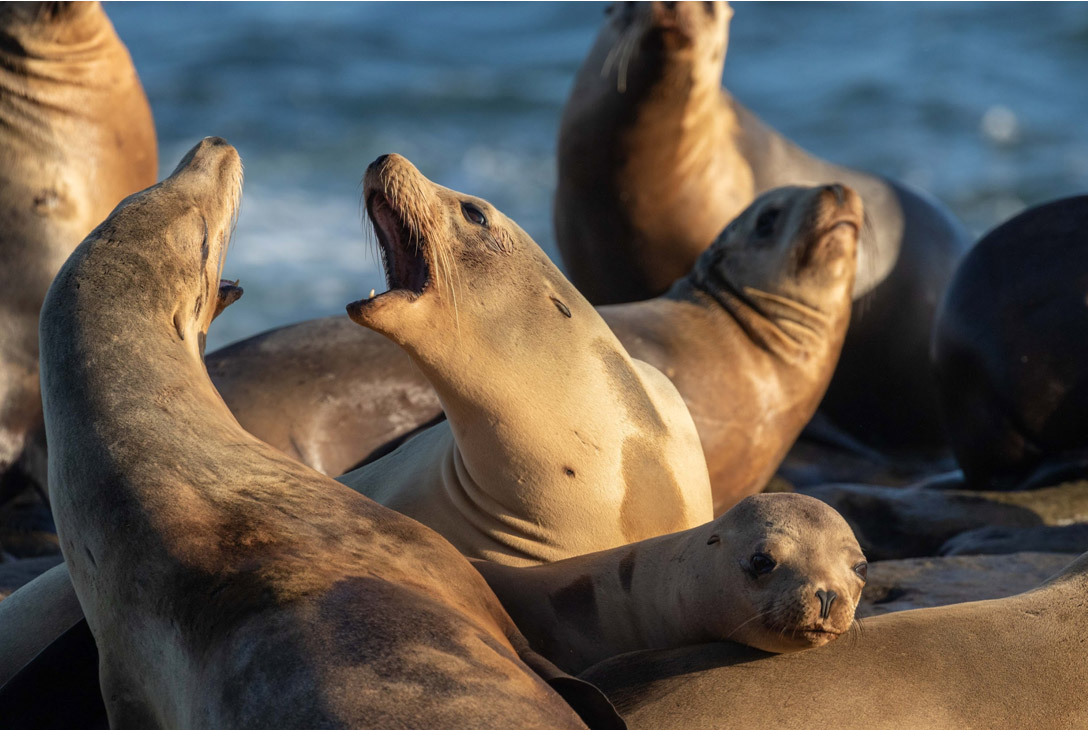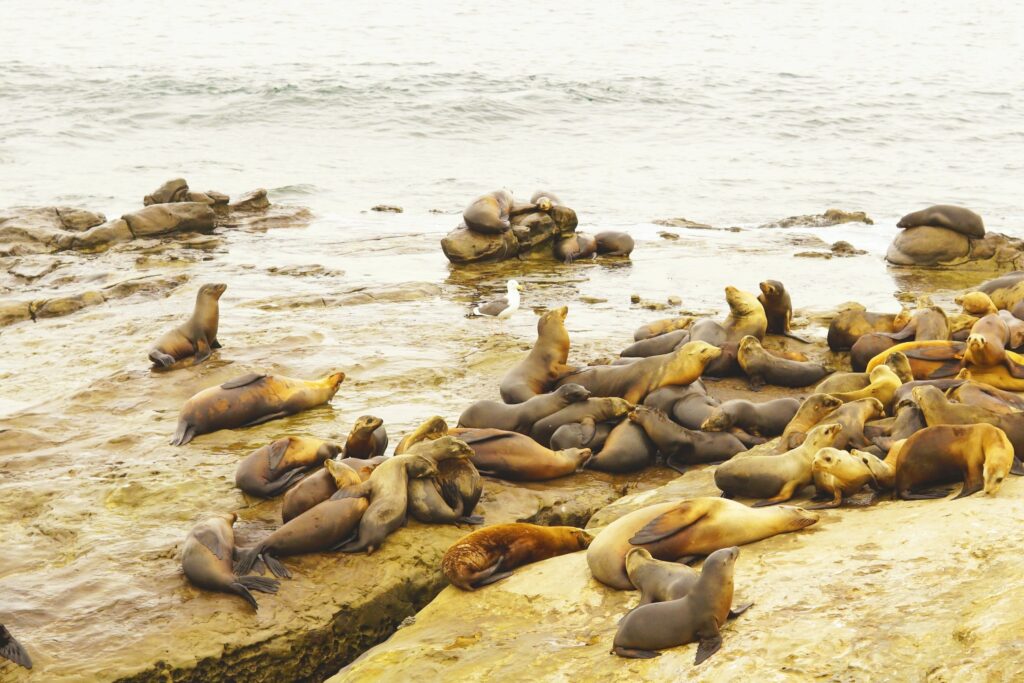
Explore one of California’s most iconic marine protected areas, where sea lions bask on cliffs, leopard sharks cruise the coves, and ocean life thrives under strong environmental protections. And hey—if the summer swell takes a nap, it’s the perfect excuse to ditch your board for a snorkel mask and explore the underwater lineup.
What Is the Matlahuayl State Marine Reserve?
The Matlahuayl State Marine Reserve (SMR) is a no-take zone, meaning no fishing, collecting, or disturbing marine life is allowed. Located at La Jolla Cove, this reserve protects:
- Rocky reef and kelp forest habitats, which truly feel like San Diego’s own underwater aqua-forest.
- Spiny lobsters, leopard sharks, sea stars, and garibaldi—and no, you can’t grab a lobster for your post-surf taco. These critters are strictly hands-off and total VIPs in the marine world.
- A popular launch site for snorkeling, diving, and kayaking—perfect for when the surf’s flat and you still want a salty adventure. Think of it as a mellow paddle session with sea lion side-eye.
Why La Jolla’s MPA Is Unique
- Urban-meets-nature: Nestled within our bustling coastal town, between historical homes and old-school buildings, the SMR remains a tranquil refuge for both locals and visitors.
- Educational access: Nearby programs like Birch Aquarium and local surf schools give you a real up-close look at marine life and conservation.
- Abundant biodiversity: Sea lions, harbor seals, bat rays, and giant kelp create a vibrant underwater ecosystem—they even end up in the surf lineup sometimes!

Activities You Can Do in the Matlahuayl SMR
✓ Allowed Activities:
- Snorkeling Tours: Check the local shops around that offer safe snorkeling tours for best experiences—and remember, support your local La Jolla businesses while you’re at it. There’s a few places, like La Jolla Surf Systems, to rent snorkel equipment if you forget yours.
- Scuba diving: There’s one dive shop by La Jolla Shores with tanks and such. Or book a tour with a local guide.
- Kayaking: There’s a handful of kayaking shops and tours available to book ahead or try a walk-in. The highlight of booking a kayak tour is to venture into the sea caves by The Cove. You can rent kayaks at some shops but non-tour guided kayaking can not go into the sea caves due to risk problems.
- Paddleboarding or Stand Up Paddeling (SUP): Summer is IMO the best time to you can paddle board in the marine reserve area. You can see the loads of leopard sharks during the winter and fall.
- Nature photography and tidepool observation—observe, don’t take. During ultra-low tides, or aka King Tides, the natural tidepools become exposed letting kids and adults explore the ecosystem of the marine reserve.
⊘ Not Allowed Inside the Marine Reserve:
- Fishing or collecting wildlife—lifeguards and local marine enforcement officers will cite you, or even worse, La Jolla locals might toss you in the stingray pit.
- Spearfishing or lobster trapping—if that’s your thing, head south of The Cove to areas designated for fishing and diving. Check the official maps to be sure.
- Disturbing marine mammals or birds—instead, bring a waterproof camera or a local marine guidebook. Get curious in a respectful way and let your lens do the collecting. Don’t be that person trying to per a sea lion, just saying.
Pro Tip: Always launch outside the SMR zone and check the latest updates via California’s MPA Map: https://wildlife.ca.gov/Conservation/Marine/MPAs/Network
La Jolla’s Role in California’s MPA Network
The Matlahuayl SMR is part of California’s network of 124 marine protected areas, all designed to:
- Rebuild fish populations—because yeah, all that plastic and overfishing really adds up.
- Protect sensitive habitats—with education for both locals and visitors playing a huge role in preserving what we love.
- Enhance scientific research and climate resilience—thanks to institutions like Scripps that are constantly dialing in new data to protect our coastlines.

How to Explore Responsibly
Before heading out, follow these eco-conscious tips:
- Pack reusable water bottles and reef-safe sunscreen. Seriously, if we still have to say this, then we really hope this blog helps you get on board.
- Stay at least 50 feet from marine mammals. Sometimes the animals come to you—don’t panic. Most marine life in La Jolla is harmless and just straight-up curious.
- Join a guided eco-tour or educational snorkel session. We know some awesome local shops that offer both self-guided and group options. (Links coming soon.)
- Support local businesses that walk the talk when it comes to ocean stewardship.
FAQs About the Matlahuayl Marine Reserve
Q: Can I swim or kayak in the reserve?
A: Yes, as long as it’s non-extractive recreation, you’re good to go.
Q: Can I swim or kayak in the reserve?
A: Yes, as long as it’s non-extractive recreation, you’re good to go.
Q: Where does the reserve begin and end?
A: It stretches across La Jolla Cove and extends out into the ocean. Always double-check the maps.
Q: Is there a difference between a “conservation area” and a “reserve”?
A: Yup. A State Marine Reserve is stricter—no take, no exceptions. Conservation areas allow limited fishing.
Q: Is there any surfing allowed in La Jolla’s marine reserve area?
A: Yes and no. The Cove fires during winter swells with waves hitting 20ft+, but it’s strictly for the experts. Devil’s Slides is another spot, but it’s a long paddle to a shallow reef near The Castle house—again, for experienced surfers only. Summer? Not so much. It’s more about snorkeling and cruising calm waters. For more on seasonal surf and local breaks, check out our upcoming blogs.
Dive In—Experience and Protect La Jolla’s Ocean Jewel
Want to experience the Matlahuayl Reserve with a little local guidance?
- Book a marine science surf camp or lesson with Surf Education Academy: https://surfeducationacademy.com/surf-camps
- Join a kelp forest snorkel tour or sign up for a local beach cleanup through orgs like the Surfrider Foundation.
- Post your visit and tag #LaJollaMPA to help us spread that ocean love.
History of the Matlahuayl State Marine Reserve
Established in 2012 under California’s Marine Life Protection Act Initiative, the Matlahuayl State Marine Reserve is one of the most ecologically vibrant pockets of the state’s coastline. Its name pays homage to the local Kumeyaay people, who’ve lived in balance with this coastline for thousands of years. Today, it’s managed by the California Department of Fish and Wildlife, and it plays a massive role in preserving biodiversity, educating the public, and driving forward marine research—exactly the kind of work we’re trying to amplify with this blog.
Wildlife Spotting Guide: What to See and When
Matlahuayl SMR is alive year-round with marine life. Here’s what to watch for:
- Leopard Sharks (June–September): These gentle sharks gather in warm, shallow water by the Shores. No sharp teeth, just sandpaper jaws made for grinding crabs—still, your heart might skip when one glides beneath your board.
- Sea Lions and Harbor Seals (Year-round): Often spotted sunbathing on rocks or cruising alongside snorkelers. They’re the OG locals—cool, curious, and loud when they wanna be.
- Garibaldi (Year-round): These bright orange beauties are like little underwater traffic cones—easy to spot, very territorial.
- Gray Whales (December–April): Migrating down the coast. You can often catch a fluke or two from the cliffs above. Usually too far and rarely ever get close enough to the inside snorkel zones. Usually seasonal and passes through the deeper channels.
- Bat Rays and Guitar Fish (Spring–Summer): Gliding across the sandy bottom like lowriders of the sea. They look scary but they’re harmless
- Stingrays (Spring–Late Summer/Early Fall): The one animal to watch your step for. Stingrays bury in the shallows to eat crabs and stay hidden. Shuffle your feet as you walk out and you’ll be fine.
Self-Guided Exploration: Kayak and Swim Tour Route
Start your journey from La Jolla Shores. Paddle south toward the Sea Caves, loop around to La Jolla Cove, and soak in some of California’s most iconic underwater views. Along the way you might spot leopard sharks, sea lions basking on the cliffs, dolphins, or even the elusive La Jolla green sea turtle. Cap it off with a float above the underwater canyon—pure magic. Just make sure to respect boundaries and avoid no-entry zones.
MPA Myths vs. Facts
Myth: “You can’t enter an MPA.”
Fact: Actually, most MPAs are open for non-extractive recreation like diving, kayaking, and snorkeling.
Myth: “MPAs are bad for local businesses.”
Fact: MPAs are a big win for eco-tourism. They support jobs, education, and businesses that go through proper training and licensing to serve guests while protecting marine life.
Myth: “One reserve can’t make a difference.”
Fact: When combined into a network like California’s 124 MPAs, these protected zones become powerful forces for ecological recovery.
Why It All Matters—for Surfers, Scientists, and Sea Lovers Alike
The Matlahuayl State Marine Reserve isn’t just a blue spot on the map. It’s proof of what happens when we show up for the places we love. Whether you’re a dawn-patrolling surfer, a scientist diving into the kelp forest, or a family playing in the tide pools, this reserve gives you front-row access to an ocean that still feels wild.
So respect the rules, share the stoke, and live by the “Ocean and Surfer Code”: Leave it better than you found it. When the lineup stays clean, the lobsters stay safe, and the reef keeps buzzing—that’s the legacy we all want to share. That’s what makes this reserve so special.
That’s what makes La Jolla the real jewel.


 Dive into the History of Surfing at La Jolla Shores
Dive into the History of Surfing at La Jolla Shores